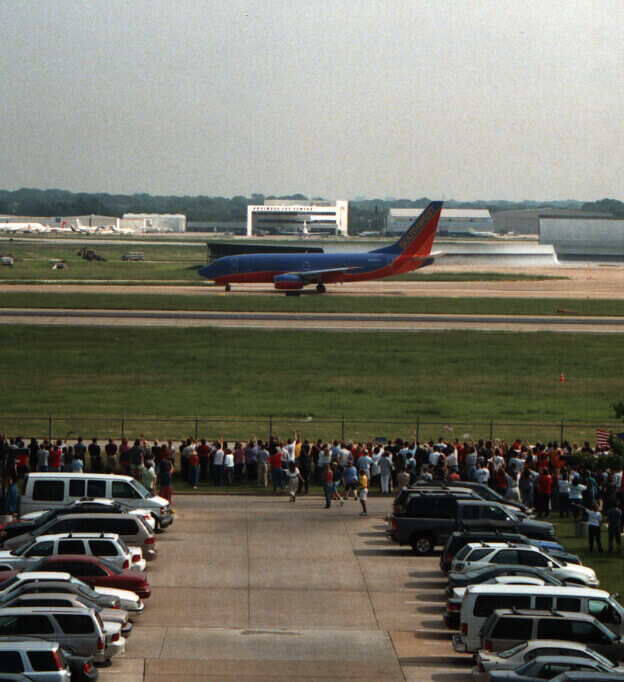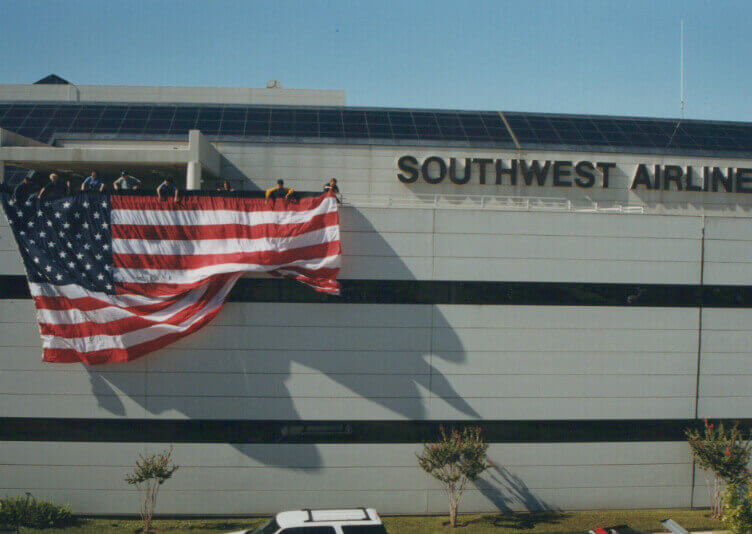
A crowd of Southwest Employees gathers on September 14, 2001, to watch the first Southwest flight from Love Field after September 11.
A Shining Light in the Darkest of Hours: Southwest and 9/11
We will do everything in our power to avoid layoffs at Southwest Airlines. That was one of the first vows made on the morning of September 11, 2001, as Southwest Leaders huddled in a makeshift crisis command center at its Dallas Headquarters. Whatever was to come in the hours and months ahead, Southwest would endure it together as one tight-knit Family.
Earlier that morning, terrorists hijacked four commercial airplanes. One plane struck The Pentagon, another two were intentionally flown into the twin towers of the World Trade Center in New York. And a fourth, which was intended to strike the U.S. Capitol, was overtaken by onboard passengers who thwarted the intended attack and crash-landed the plane in a field near Shanksville, Pennsylvania.
All passengers aboard these planes were killed, as were a then-unknown number of people in the World Trade Towers. In response, the FAA ordered an immediate grounding of all 4,546 civilian aircraft in U.S. airspace. Beyond the immediate security issues, the unprecedented grounding raised a question no one had ever needed to pose: How long would it take for air travel to return to the United States?
Despite the chaos and harrowing images flickering on TVs across the nation, neither fear nor panic crossed the threshold into the Southwest boardroom. The room was a rampart of mutual trust and quiet resolve.
The fact that Southwest had just completed a major Leadership transition months earlier—elevating Jim Parker to CEO, Colleen Barrett to President, and Gary Kelly to Executive Vice President—might have crippled a lesser organization. But within Southwest, everyone knew their responsibilities and how to perform them. And with Founder Herb Kelleher by their side, scrawling notes on his trademark notepad with a simple No. 2 pencil, everyone felt an unshakable confidence that Southwest had been built to not only survive but prevail during such a moment. If it could keep its extended Family safe—Employees and Customers alike—Southwest could see its way through the crisis.
The immediate goal was to confirm all planes and Customers were safely on the ground. Juggling every phone he could find, as then-Vice President of Safety, Security & Flight Dispatch Greg Wells provided a running tally of how many Southwest planes had landed. It was a countdown like no other in the Company’s history—190 airplanes, 170, 100, 50, 20—until only one plane remained unaccounted for.
After a nail-biting stretch of silence, Greg finally received word that the final plane had been safely rerouted to Grand Rapids, Michigan. Leadership released a collective sigh of relief, then it turned its attention to the host of logistical and financial dangers lurking on the horizon.
One of the first notes Herb had scrawled on his note pad was the simple directive “Get cash.” Although Southwest had plenty of money in the bank, Herb knew that raising additional capital—in his words “all the cash we possibly could”—translated into job security and money for its Employees during what was likely to be a punishing economic downturn.
Fortunately, Southwest Airlines boasted the strongest balance sheet and credit ratings in the U.S. airline industry, not to mention the talent and financial expertise to navigate this crisis.
At the time, Southwest was within a week of funding its Profitsharing Plan with the previous year’s contribution. Despite the fact that every dollar was precious and Southwest could have easily halted that contribution given the circumstances, Leadership stayed true to its commitment and disbursed funds to Employee profitsharing accounts, believing it was undoubtedly the right course of action.
Just as importantly, Southwest needed to maintain its Heart and the confidence of its People. For they all believed deeply in the Southwest philosophy that said: “Leading an organization is as much about soul as it is about systems.”

At Southwest Airlines Headquarters, Employees work together to unfurl an enormous American flag shortly after the September 11 attacks.
Jim kicked things off as CEO by sending a letter to every Southwest Employee that said, in effect: We don’t know what the future holds, but know this: Your jobs are safe, and we’re going to keep issuing paychecks even though not a single plane is in the air.
The fact that, within a week of the attacks, rival airlines announced major job cuts spoke volumes about the character of Southwest Airlines.
The Company worked to get its planes in the air as quickly as possible once the grounding was lifted. As then-Vice President of Ground Operations Dave Ridley said, “It’s wonderful when you marry a promise with an ability to deliver.”
And deliver Southwest did. Herb was called to Washington to help shape new protocols for what would become the Transportation Security Administration (TSA). He proved instrumental in persuading officials to dial down some of the more restrictive measures initially proposed, protecting not only Customers’ rights but the entire industry itself.
Meanwhile, the Southwest financial Team untangled a host of knots. Lines of credit were called in. Spending was curtailed. And insurance issues rectified. It was just one facet of a Companywide effort to restart operations. New flight schedules, which usually took weeks to create, were created in just a few days. And at Southwest Headquarters and in airports across the country, Employees worked around the clock to implement new security protocols.
Many worked 18- to 20-hour days or straight through weekends, while others worked tirelessly all day and then slept in their offices to be ready to jump up and do it all again. Retirees returned to chip in. And some Customers, totally unprompted, mailed Southwest unused travel vouchers and cash to support its efforts.
After September 11, the skies over America were eerily silent for days. On September 14, Southwest was the first airline to return to the skies. No other domestic airline had mastered the logistics needed to ready all of its planes for flight by that day. There was something undeniably special about those initial Southwest flights after September 11. Facing widespread fears that terrorists would strike again, it took real courage for Southwest Pilots, Flight Attendants, and Customers to get on that first plane.
The Southwest offices look out onto the runway of Love Field, so while preparing for the takeoff of Southwest’s first flight from Love Field post-9/11, the Captain told Customers to look out their windows. A swell of Southwest Employees had gathered behind a security fence, flying banners and waving flags, to see the plane off. “It was,” one member of the crowd later noted, “almost like, as a Company, we wanted to get as close to that plane as possible.”
Someone in the crowd began singing “God Bless America.” One voice, then another, joined in. The song crested in a soulful chorus of pride, unity, and heartfelt emotion. Happy tears and weeping sighs drowned out the final measures of the song as the plane lifted into the sky and the history books.
In the months to follow, Southwest made good on a series of commitments few thought possible. As originally planned, Southwest added service to Norfolk, Virginia, in October 2001. Then, thanks to its belt-tightening and efficiencies, Southwest produced a near-miracle byturning a profit at the end of the year. All this was achieved while maintaining its profitsharing commitments and offering job security for all Employees during one of the most difficult times in American airline history.
As then-Vice President of Governmental Affairs Ron Ricks said, the Company’s efforts “reinforced, for all time, in America, that the people of America could count on Southwest Airlines—that we were gonna be there for them.”
